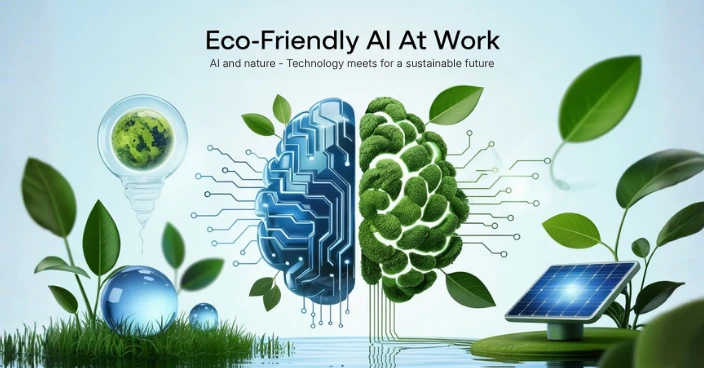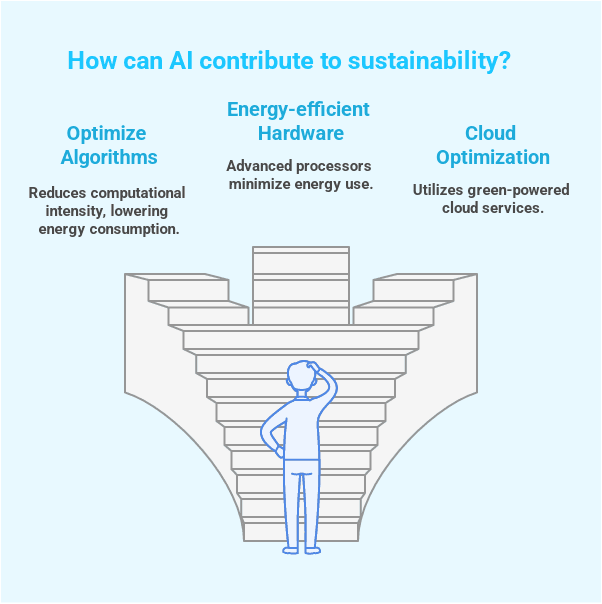

Are you ready to disrupt with AI? Join our Hackathon today! Click to Register
By WebOsmotic Team | Published on January 31, 2025
Summarize Article

Table of Contents
ToggleTechnology has been an ally in combating the world’s most critical environmental problems nowadays. Among the many such technologies, Eco-Friendly Artificial Intelligence is now at the forefront. It allows approaches that would be effective and innovative yet impactful in the reduction of climate change, natural resource conservation, and sustainable living. This article talks about the current evolution of Green AI, and how it will transform future efforts in sustainability along with innovative applications for which it can be considered essential for a greener tomorrow.
Eco-friendly AI is artificial intelligence systems designed or used with the presumption of sustainability. In this category, systems that minimize energy use, maximize resource consumption, and reduce environmental footprints are eligible. Organizations can adopt Sustainable AI practices such as energy-efficient algorithms and ethical development processes to carry out AI while not adversely affecting the health of the planet.
Green AI is all about reducing the carbon footprint of AI technologies. Conventional AI models consume a lot of energy, especially those using large computational resources. Green AI aims at:

Diverse applications of AI include contributions to different aspects of environmental sustainability. The following are key areas where AI has driven a paradigm shift:
With climate issues dominating the global agenda, AI and Climate Change are tackling the issue and contributing enormously to its resolution:
• Weather Prediction: AI models analyze massive datasets to deliver an accurate weather forecast, thus preparing communities against adverse events.
• Carbon Emissions Tracking: These AI systems track and measure carbon emissions, which informs corrective measures by the industries.
• Renewable Energy Integration: It forecasts energy generation and manages its distribution to ensure its efficiency by utilizing renewable energy sources. It includes solar and wind technology to create valuable energy optimization.
Agriculture, itself a major cause of and suffers from climate change, thus needs sustainable solutions offered by AI to the sector:
• Precision Farming: AI-enabled tools monitor soil condition, water use, and crop conditions to minimize wastage of resources.
• Pest Control: AI systems detect and predict pests, enabling effective pest intervention while reducing the harmful use of pesticides.
• Optimization in Crops Yield: AI seizes weather and soil data and advises on the best time to plant and which crops.
How waste is managed and reduced has changed dramatically through AI:
• Smart Sorting: AI can very accurately identify and sort recyclable materials out of the waste streams.
• Waste Reduction: Consumption patterns are predicted by the AI, helping industries cut waste at the sources of production.
• Circular Economy: AI promotes reuse and recycling of materials, thereby enhancing all sustainable living.
Energy-efficient AI solutions are critical to achieving sustainability goals:
• Smarter Grids: AI matches energy distribution with demand and creates a real-time balance between supply and demand.
• Building Automation: Automated AI-managed systems regulate the management of lighting, heating, and air conditioning in general buildings to cut energy use.
• Energy Forecast: Energy demand as predicted by AI gives room for proper planning and avoids wastage of energy.
AI is a life changer as far as preserving biodiversity and keeping wildlife protected is concerned.
• Animal Following: AI drones and camera aerial surveillance monitor animals’ “populations” by tracking movement and behavior.
• Stop Poaching: AI systems study patterns in poaching detection and eventually help to prevent illegal activity as well.
• Habitat Restoration: AI can map areas where engines fail and plan restoration for degraded ecosystems.
AI will be the foundation for sustainability. The development of Energy-Efficient AI will help improve the environmental impact due to AI itself. The following are some strategies:
• Any compact models developed: Compressing AI models into a compact space that does not affect output performance.
• Federated Learning: training AI models on decentralized devices manipulating as little data transfer as possible and thus using less energy.
• Low-Power AI Chips: AI task-focused processors that work on developing a processor particular for AI tasks requiring less energy.
• Data Center Optimization: By managing cooling systems and power use of the data center, AI can improve the efficiency of the data center.
When AI meets efforts to achieve sustainability, it has many advantages:
• Resource Optimization: AI improves the effective use of industrial resources, resulting in reduced waste in addition to cost.
• Scalability: From urban planning to ocean conservation, AI solutions can be scaled to address global challenges.
• Data-Based Insights: AI analyses huge data sets and makes feasible access to gems of insight otherwise not possible.
• Enhanced collaboration: Through AI, governments, NGOs and industries can develop collaborative partnerships by generating platforms for common action.
However, the promise of AI for sustainability comes with pitfalls. Some of them include:
1. Energy Consumption: Current advancements notwithstanding, training large AI models still consumes huge amounts of energy.
2. Algorithmic Bias: Algorithmically unfettered AIs are crucial to determining fair outcomes against bias.
3. Data Protection: Sensitive environmental and industrial data should be secured.
4. Accessibility: The affordability and accessibility of AI solutions to developing countries is a requirement for sustainability across the world.
The future is bright for Eco-Friendly AI, and ongoing advancements will likely increase its impact. Crucial trends include the following:
• Decentralized AI:- It minimizes reliance on energy-hungry data centers through edge computing.
• AI-Powered Renewable Energy: Create all AI-powered renewable energy systems and make them available worldwide.
• Global Collaboration: AI will play a focal role in helping countries achieve greener goals, like the Sustainable Development Goals (SDGs) defined by the United Nations.
Eco-friendly AI is not just technology-based advancement but is fundamentally a necessity of future-sustaining development. AI emerges as a powerful instrument. It potentially brings about change to solve problems such as climate change, depleting resources, and biodiversity loss. It ranges from Green AI practices for the innovative use of applications in waste management, agriculture, energy efficiency, and beyond; the list of possibilities is endless. As we keep innovating and adopting Sustainable AI practices, the possibility of having a greener, more sustainable planet all but firmly comes into focus.
Unlock exclusive insights and expert knowledge delivered straight to your inbox